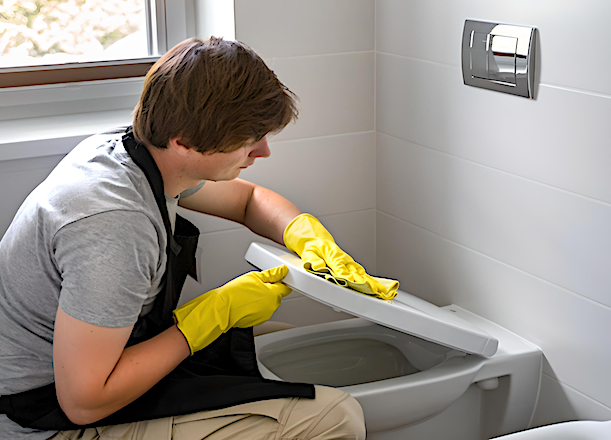
A study published in the journal ‘Nature’ warns that flushing with the toilet exposed serves to ‘expel’ viruses and bacteria up to almost seven feet (two meters) away. In many households, people leave the toilet lid up after using it. But, although few know it, there is scientific data on the dangers of keeping the top up.
Research from the University of Colorado, USA, measured the impact of flushing with the toilet lid up. The idea was to know if the coronavirus could be transmitted by aerosols generated in bathrooms with contaminated feces. They used two lasers, a toilet, and measurement and analysis chambers to carry out the study. The results surprised even the researchers themselves. They did not expect that when flushing the toilet, tiny drops would fly out and float around the bowl due to the force of the water in the cistern. Moreover, traveling at speeds of more than seven feet per second!
The largest droplets, the ones we see with the naked eye, fall quickly and close to the toilet, but the small ones remain floating in the air for several minutes. The problem is that these water droplets are contaminated with pathogens, such as E. coli or norovirus, that come from our feces and urine.
Viruses and bacteria in our bathroom can stick to walls, floors, towels, faucets, and even toothbrushes. By lowering the lid, we will not prevent the contaminated droplets from flying out, but they will remain stuck inside the top. So we must clean and disinfect this surface frequently. Other actions are ventilating the bathroom, opening a small window, or using an air extraction system.
And in public bathrooms that don’t have a lid? In this case, and if there is no choice but to use them, we can only leave the bathroom as soon as possible. Bathrooms without proper hygiene are a breeding ground for various diseases, as they can harbor germs and bacteria. Some conditions related to dirty bathrooms or without adequate hygiene include:
1️⃣ Urinary tract infections. A dirty toilet contains bacteria that cause urinary tract infections if they come into contact with the urethra.
2️⃣ Stomach flu. Lack of hygiene in a bathroom leads to fecal contamination on surfaces and the spread of bacteria such as Salmonella and E. coli, which cause gastroenteritis and diarrhea.
3️⃣ Fungal infections. Dampness and lack of proper bathroom cleaning can encourage fungi growth, such as mold, leading to fungal infections of the skin and nails.
–––––
–––––
––––––––––
4️⃣ Respiratory infections. A bathroom with poor ventilation and mold buildup worsens indoor air quality and contributes to respiratory problems such as allergies and asthma.
5️⃣ Dermatitis and skin allergies. Exposure to irritating chemicals in cleaning products or allergens such as mold and dust mites causes dermatitis and other skin reactions.
6️⃣ Diseases transmitted by insects. Lack of hygiene in a bathroom attracts insects such as flies and cockroaches, which carry diseases and spread germs.
7️⃣ Mental health concerns. A neglected bathroom hurts mental health, increasing stress and anxiety, especially in people sensitive to cleanliness and organization. Keeping the bathroom clean and well-ventilated is vital to prevent moisture and mold from accumulating. It’s also important to wash your hands thoroughly after using the toilet to reduce the risk of spreading germs.
––––––––––
🟧 ❇️ VIEWPOINTS
––––––––––
✅ “Maintaining good hygiene in the bathroom and throughout the home is life or death to prevent illness. Lack of proper cleaning and disinfection in a home increases the risk of infections, allergies, and skin problems.” George H. Mendey, Doctor of General Medicine.
✅ “Good hygiene at home prevents the transmission of pathogens. Common surfaces should be cleaned once or twice a week, and good ventilation must be maintained to reduce the risk of the spread of infectious diseases.” Henry Fisher, Epidemiologist.
✅ “You have to worry about the medium and long-term effects of living in an unhealthy environment. We must combat dust, mites, mold, and other allergens in the home to avoid respiratory difficulties and allergies. Equally important is using non-toxic cleaning products to protect environmental health.” Dorys Ramos, Environmental Health Specialist.
⭕️ A single deep cleaning and then disregarding the hygiene of your home will not be enough to help in the prevention of bacteria and diseases. Many cleaning activities are recommended to be done daily, as in the case of cleaning the kitchen, or about three times a week, as in the case of vacuuming and sweeping.
––––––––––
––––––––––
––––––––––
––––––––––
––––––––––
––––––––––
